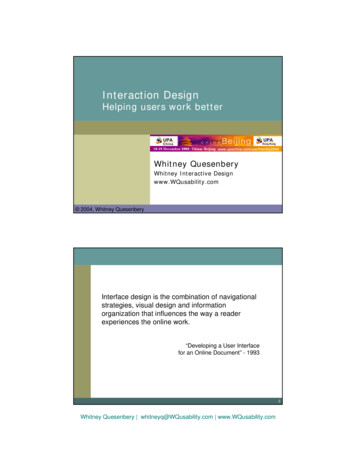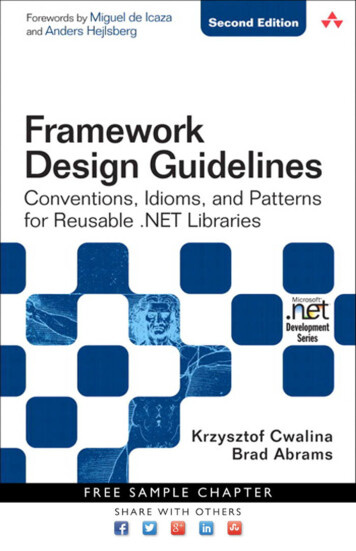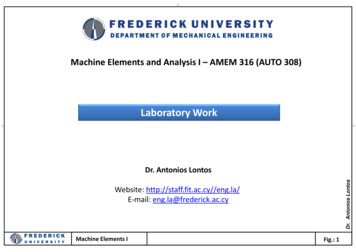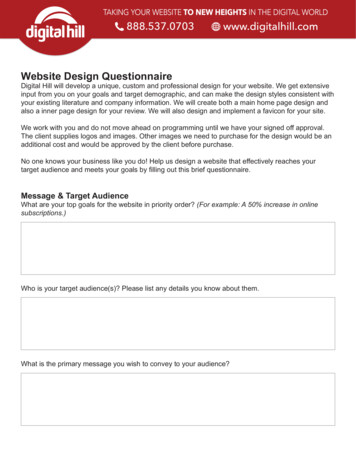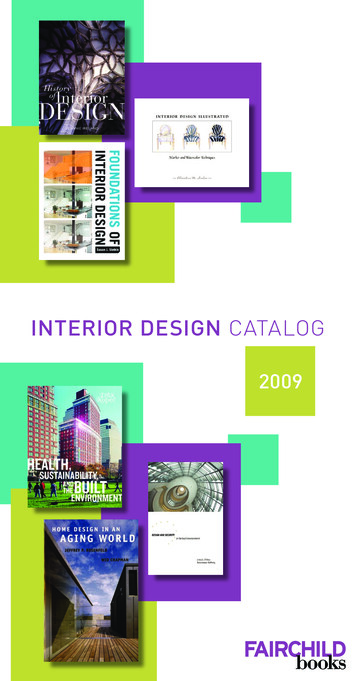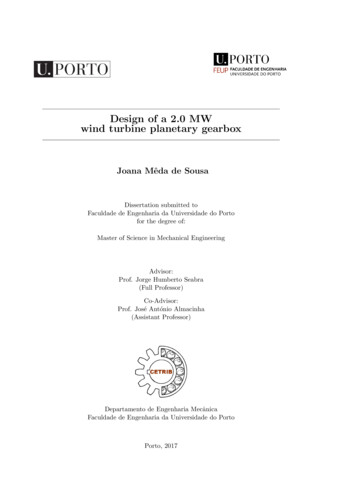
Transcription
Design of a 2.0 MWwind turbine planetary gearboxJoana Mêda de SousaDissertation submitted toFaculdade de Engenharia da Universidade do Portofor the degree of:Master of Science in Mechanical EngineeringAdvisor:Prof. Jorge Humberto Seabra(Full Professor)Co-Advisor:Prof. José António Almacinha(Assistant Professor)Departamento de Engenharia MecânicaFaculdade de Engenharia da Universidade do PortoPorto, 2017
The work presented in this dissertation was performed at theUnit of Tribology, Vibrations and Industrial MaintenanceDepartment of Mechanical EngineeringFaculty of EngineeringUniversity of PortoPorto, Portugal.Joana Mêda de SousaE-mail: up201502887@fe.up.ptFaculdade de Engenharia da Universidade do PortoDepartamento de Engenharia MecânicaUnidade de Tribologia, Vibrações e Manutenção IndustrialRua Dr. Roberto Frias s/n, Sala M2064200-465 PortoPortugal
AbstractIn recent years there has been much attention to the production of electricity from wind;this is performed by wind turbines. They have been used since ancient times to producemechanical energy with other objectives than producing electricity, like grind grains. Butthe real explosion, in the use of wind turbines to produce electricity, occurred from 1970onwards, when, because of the oil crisis, new ways to produce energy were sought.A central component in every wind turbine design is the gearbox. Its reliability andcost are critical factors in the success of the overall design. Historically, the wind turbineindustry has been plagued with gearbox failures, which have affected virtually every typeof wind turbine configuration.Many of these failures can be directly attributed to poor communication between thewind turbine engineer and the gearbox supplier. Successful wind turbine gearbox applications require a close working relationship between these two disciplines, with the activeinvolvement of the wind turbine engineer during the design and procurement process. Thewind turbine engineer must have enough knowledge to specify the application, environment, loads, gear life and quality, acceptance criteria, noise, and many other factors, andrelate this information to the gearbox vendor. Gearbox life expectancy will depend on theability of wind turbine operators to make informed decisions about operation and maintenance.The main objective of this dissertation will be the design and dimensioning of a gearbox capable of adapting the low rotations and high torque of the blades of a wind turbineunder conditions of speeds suitable for the generation of energy in the generator. To doso, a research was carried out to evaluate the current state of wind energy production,the type of equipment available, its characteristics and other existing gearboxes. The bestperforming solution was then chosen for optimization. KISSsoft 2016 and KISSsys2016 were used in the dimensioning of gears, shafts, rolling bearings and keys. Keywords: Planetary gearbox, Power split stage, Wind turbine, Dimensioning, Design,KISSsoft , KISSsys , Lubrication, Oil injection.i
To my friends and family . . .ii
‘As engrenagens constituem o verdadeiro ex-libris da Engenharia Mecânica’Professor Paulo Tavares de Castroiii
AcknowledgementsI would like to thank my supervisor Professor Jorge Seabra and co-advisor Professor JoséAlmacinha, first for offering me the opportunity to perform this project and second, fortheir time devoted to this project, guidance, support, comments and wise remarks.I am grateful to Professor Paulo Tavares de Castro for the knowledge and unlimitedavailability demonstrated not only during this master thesis but also throughout all thetime I spent at Faculdade de Engenharia da Universidade do Porto. I would like to extendmy thanks to Professor Armando Vilaça de Campos who offered collegial guidance andsupport during my early years of my mechanical engineering graduation.I could not fail to mention Professor José Dias Rodrigues for the encouragement andhelp in the use of appropriate text editing tools that simplified the writing and presentation of this dissertation, as well as, for its essential contribution and mentor ship duringmy graduation.I wish to express a deep gratitude to the incredible colleagues that I met at CETRIB,for all the inexhaustible help, friendship, support and unforgettable moments in the lastfew months: João Sousa e Carlos Pereira. Thanks a lot!I cannot forget to thank the Faculdade de Engenharia da Universidade do Porto,CETRIB (Unit of Tribology, Vibrations and Industrial Maintenance), LAETA and SciTech for the opportunity and the conditions provided to perform this dissertation.Last but not the least, my most heartfelt thanks go to my mother and family who havesupported me to perform my master degree and without them I would not be the personI am now.v
ContentsAbstractiAcknowledgementsv1 Introduction1.1 Background . . . .1.2 Objectives . . . . .1.3 Problem definition1.4 Layout . . . . . . .I1122352 State of art2.1 Introduction . . . . . . . . . . . . . . . . . . . . . . . .2.2 Brief overview of wind turbine conversion systems . .2.2.1 Global wind power . . . . . . . . . . . . . . . .2.2.2 Development of wind turbine power . . . . . .2.2.3 Costs of wind turbine conversion systems . . .2.3 Wind turbine technology . . . . . . . . . . . . . . . . .2.3.1 Configurations and main components of a wind2.3.2 Power controls . . . . . . . . . . . . . . . . . .2.4 Gearbox in a wind turbine . . . . . . . . . . . . . . . .2.4.1 Description . . . . . . . . . . . . . . . . . . . .2.4.2 Concepts . . . . . . . . . . . . . . . . . . . . .2.4.3 Market search . . . . . . . . . . . . . . . . . . . . . . . . . . . . . . . . . . . . . . . . . . .turbine. . . . . . . . . . . . . . . . . . . . .II777791011111313141521253 Gearbox Design and Dimensioning3.1 Transmission . . . . . . . . . . . . . .3.1.1 Number of transmission stages3.1.2 Shaft arrangement . . . . . . .3.1.2.1 1st Stage . . . . . . .3.1.2.2 2nd and 3rd Stages .3.1.3 Gear type and Helix angle . . .3.1.3.1 1st Stage . . . . . . .3.1.3.2 2nd and 3rd Stages .3.1.4 Module and number of teeth .vii.27272728282829293030
CONTENTS3.1.53.1.63.1.73.1.8Facewidth . . . . . . . . . . . . . . . . . . . . . . . .Profile shift coefficient . . . . . . . . . . . . . . . . .Material selection . . . . . . . . . . . . . . . . . . . .Input and Output conditions . . . . . . . . . . . . .3.1.8.1 General conditions . . . . . . . . . . . . . .3.1.8.2 Operating temperature . . . . . . . . . . .3.1.8.3 Required life time . . . . . . . . . . . . . .3.1.9 Load factors . . . . . . . . . . . . . . . . . . . . . .3.1.9.1 Application factor, KA . . . . . . . . . . .3.1.9.2 Dynamic factor, KV . . . . . . . . . . . . .3.1.9.3 Mesh load factor, Kγ . . . . . . . . . . . .3.1.9.4 Load Distribution Factors, KHα and KHβ .3.1.10 Safety factors . . . . . . . . . . . . . . . . . . . . . .3.1.11 Lubricant and lubricating method . . . . . . . . . .3.1.11.1 Lubricating oil selection . . . . . . . . . . .3.1.11.2 Pressure viscosity parameters . . . . . . . .3.1.11.3 Scuffing and micropitting tests parameters3.1.11.4 Lubricating method selection . . . . . . . .3.1.12 Results . . . . . . . . . . . . . . . . . . . . . . . . .4 Gearbox Optimization4.1 Gears . . . . . . . . . . . . . . . . . . . . . . . . . . . . . . . . . . . . . .4.1.1 Load spectrum application . . . . . . . . . . . . . . . . . . . . . .4.1.2 Profile teeth modifications . . . . . . . . . . . . . . . . . . . . . . .4.1.3 Power split gearbox’s shafts assembly . . . . . . . . . . . . . . . .4.2 Shafts . . . . . . . . . . . . . . . . . . . . . . . . . . . . . . . . . . . . . .4.2.1 Assessment of the fatigue strength using nominal stresses: generalsafety factors . . . . . . . . . . . . . . . . . . . . . . . . . . . . . .4.2.2 Assessment of the fatigue strength using nominal stresses: individualsafety factors . . . . . . . . . . . . . . . . . . . . . . . . . . . . . .4.2.3 Shaft Results . . . . . . . . . . . . . . . . . . . . . . . . . . . . . .4.3 Rolling bearings . . . . . . . . . . . . . . . . . . . . . . . . . . . . . . . .4.4 Spline joints . . . . . . . . . . . . . . . . . . . . . . . . . . . . . . . . . . .4.5 Housing . . . . . . . . . . . . . . . . . . . . . . . . . . . . . . . . . . . . .4.6 Other components . . . . . . . . . . . . . . . . . . . . . . . . . . . . . . .4.6.1 Shaft seals . . . . . . . . . . . . . . . . . . . . . . . . . . . . . . . .4.6.2 Retaining rings . . . . . . . . . . . . . . . . . . . . . . . . . . . . .4.6.3 Spacer sleeves . . . . . . . . . . . . . . . . . . . . . . . . . . . . . 59. 60.III606162676971717374775 Lubrication system5.1 Introduction . . . . . . . . . . . . .5.2 Oil Circulating system conception5.2.1 Pipe material selection . . .5.2.2 Thread Ports . . . . . . . .5.2.3 Pipe End Assembly . . . .5.2.4 Pipe diameter selection . .5.2.5 Piping design . . . . . . . .viii.7979828283848791
CONTENTSIV956 Conclusion and future work976.1 Conclusions . . . . . . . . . . . . . . . . . . . . . . . . . . . . . . . . . . . . 976.2 Future Work . . . . . . . . . . . . . . . . . . . . . . . . . . . . . . . . . . . 98References100A KISSsoft Reports105A.1 KISSsoft Reports - Gearing calculation . . . . . . . . . . . . . . . . . . . . . 105A.1.1 KISSsoft Report - Planetary stage . . . . . . . . . . . . . . . . . . . 107A.1.2 KISSsoft Report - Second stage . . . . . . . . . . . . . . . . . . . . . 123A.1.3 KISSsoft Report - Third stage . . . . . . . . . . . . . . . . . . . . . 137A.2 KISSsoft Reports - Shaft calculation . . . . . . . . . . . . . . . . . . . . . . 151A.2.1 KISSsoft Report - Planetary coaxial shafts (considering nominal load)153A.2.2 KISSsoft Report - Planet shaft . . . . . . . . . . . . . . . . . . . . . 184A.2.3 KISSsoft Report - Intermediate shaft (superior branch) . . . . . . . 209A.2.4 KISSsoft Report - Intermediate shaft (inferior branch) . . . . . . . . 231A.2.5 KISSsoft Report - High speed shaft (Output) . . . . . . . . . . . . . 257A.3 KISSsoft Report - Thermal analysis . . . . . . . . . . . . . . . . . . . . . . 283A.3.1 KISSsoft Report - High speed shaft . . . . . . . . . . . . . . . . . . . 285B Assembly drawing291ix
CONTENTSx
List of 2.142.152.16Profile evolution of cumulative installed capacity worldwide of 2001–2016,[2]. . . . . . . . . . . . . . . . . . . . . . . . . . . . . . . . . . . . . . . . .Annual Installed Capacity by Region 2008-2016. Total new wind energycapacity globally installed of 54 642 MW. For a more detailed informationshould be consulted the data source, [2]. . . . . . . . . . . . . . . . . . . .EU market shares for new wind energy capacity installed during 2016. Totalof 12 490 MW, [1]. . . . . . . . . . . . . . . . . . . . . . . . . . . . . . . .At the left, in the circular chart, share of new installed capacity during2016 (total 24 484 MW). At the right, the cumulative power capacity in theEuropean Union 2005-2016, [1]. . . . . . . . . . . . . . . . . . . . . . . . .Evolution of wind turbine size (Ø: rotor diameter; H: tower height). All datacan be founded in different articles, manufactures reports and datasheets,[3–11]. . . . . . . . . . . . . . . . . . . . . . . . . . . . . . . . . . . . . . .Leveled cost of energy in United States. U.S. federal tax subsidies remainan important component of the economics of Alternative Energy generationtechnologies (and government incentives are, generally, currently importantin all regions), [12]. . . . . . . . . . . . . . . . . . . . . . . . . . . . . . . .Horizontal and vertical axis wind turbines, [3]. . . . . . . . . . . . . . . .Transmission ratio i versus the rated turbine speed nrotor , [3]. . . . . . . .Three spur wheel stages arrangement, [18]. . . . . . . . . . . . . . . . . .One planetary-Two parallel stages gearbox, [18]. . . . . . . . . . . . . . .Kinematic diagram of a fixed ring epicyclic gear drive. . . . . . . . . . . .Two planetary-One parallel gear stage gearbox, [18]. . . . . . . . . . . . .Compound planetary gearbox, [18]. . . . . . . . . . . . . . . . . . . . . . .Differential planetary gearbox, [18]. . . . . . . . . . . . . . . . . . . . . . .Several gearbox concepts: (a)Planetary gear stage, fixed Planet: RenkAerogear; (b) Hydraulic torque limiting: Henderson Gearbox; (c) PowerSplit, several Generators: Clipper ; (d) Two inputs: Luv and Lee Rotor,Kowintec, [18]. . . . . . . . . . . . . . . . . . . . . . . . . . . . . . . . . .Global market share of the world’s leading wind turbine manufacturers in2016, [21]. . . . . . . . . . . . . . . . . . . . . . . . . . . . . . . . . . . . . . . . . . . . . . . . .gears, [18]. . . . . . .7.8.8.9. 10.101215161616191920. 20. 213.13.23.33.4Axial pitch of a helical gear. . . . . . . . . . . . . . . .Maximum length of the gear meshing line, TT’, [31]. .Load distribution factor as a function of the number ofLubrication methods by Henriot, [42]. . . . . . . . . .4.1Revolutions distribution. Adapted from a DLC suggested by IEC 61400-4,[34]. . . . . . . . . . . . . . . . . . . . . . . . . . . . . . . . . . . . . . . . . 50xi. . . . . . .planet. . . .29313945
LIST OF eformation and meshing interference in loaded, pure involute gear, [43]. .Material removal region in a tip relief modification, [43]. . . . . . . . . . . .Tip relief on a gear tooth, [43]. . . . . . . . . . . . . . . . . . . . . . . . . .Profile diagram of the driving flank. Profile diagram of the driven flank.Load variation. Hertz pressure profile variation. Tooth mesh. Adaptedfrom Henriot [43] and MAAG [19]. . . . . . . . . . . . . . . . . . . . . . . .Second and third gearbox stages layout. . . . . . . . . . . . . . . . . . . . .Reference positioning of seconf and third gear stages. Both intermediatepinion and gear are positioned exactly on the same orientation. . . . . . .Second and third gearbox stages assembly parameters. . . . . . . . . . . . .Curvilinear quadrilateral. . . . . . . . . . . . . . . . . . . . . . . . . . . . .Face-to-face tapered roller bearing arrangement and its normal lines. Adaptedfrom: [49]. . . . . . . . . . . . . . . . . . . . . . . . . . . . . . . . . . . . . .Example of spline fits, [55]. . . . . . . . . . . . . . . . . . . . . . . . . . . .Radial clearance of a flank fitted spline joint, [54]. . . . . . . . . . . . . . .Gear milling toll. Image for illustration only. Final D1 and D2 values willbe supplied with the toolholder. D2 80, [57]. . . . . . . . . . . . . . . . . .Tilting angle of main lid (generator side) surface, [57]. . . . . . . . . . . . .Radiamatic R35 shaft seal. . . . . . . . . . . . . . . . . . . . . . . . . . .Circumferential speed allowed by NBR and FKM SIMRIT shaft seal materials. . . . . . . . . . . . . . . . . . . . . . . . . . . . . . . . . . . . . . .Shaft seal arrangement. Radiamatic R 35 in combination with a standardV-ring. . . . . . . . . . . . . . . . . . . . . . . . . . . . . . . . . . . . . . . .Retaining ring and spacer washer arrangement. . . . . . . . . . . . . . . . .Oil distribution spacer sleeve of a paired single row tapered roller bearing,[49]. . . . . . . . . . . . . . . . . . . . . . . . . . . . . . . . . . . . . . . . .Internal axial clearance of a paired single row tapered roller bearing, [49]. . 51525253545556586368696970727273747475SAE / ISO / JIS B2351 Straight Thread Port O-Ring Upon Assembly.Source: Assembly/Installation section of [64]. . . . . . . . . . . . . . . . . . 83Tapered Thread Port. Source: Assembly/Installation section of [64]. . . . . 84Sleeve attachment with flanged and brazed assemblies. Adapted from: Assembly/Installation section of [64]. . . . . . . . . . . . . . . . . . . . . . . . 84Sleeve attachment with ferrule assemblies. Adapted from: Assembly/Installationsection of [64]. . . . . . . . . . . . . . . . . . . . . . . . . . . . . . . . . . . 85Sleeve attachment with ferrule assemblies. Adapted from: Assembly/Installationsection of [64]. . . . . . . . . . . . . . . . . . . . . . . . . . . . . . . . . . . 85Over-flanging and Under-flanging failures. Source: Assembly/Installationsection of [64]. . . . . . . . . . . . . . . . . . . . . . . . . . . . . . . . . . . 86Estimated housing shape dimensions. . . . . . . . . . . . . . . . . . . . . . . 89Circulating oil desgin. . . . . . . . . . . . . . . . . . . . . . . . . . . . . . . 93xii
List of Tables2.12.22.32.42.5Cost breakdown of a typical wind turbine, [13]. . . . . . . . . . . . . . .Possible number of planets in relation to the gear ratio Zring /Zsun , [19].Top manufactures wind turbine characteristics, [22; 23]. . . . . . . . . .Detailed ZF Friedrichshafen gearbox information and parameters, [25]. .Detailed GAMESA gearbox information and parameters, [23]. . . . . . .11182222233.13.23.33.43.53.63.73.8Number of teeth and module of final gearbox parameters. . . . . . . . . .Facewidth, axial pitch and respective ratio of final gearbox parameters. .Profile shift coefficient of each gear pair of final gearbox parameters. . . .Superficial hardening processes according to gear module value, [19]. . . .42 CrMo 4 (DIN) mechanical properties, [33]. . . . . . . . . . . . . . . . .18 CrNiMo 7-6 (DIN) mechanical properties, [33]. . . . . . . . . . . . . . .Recommended gear tooth surface roughness, [34]. . . . . . . . . . . . . . .Assignment of operational behavior to application factor. Adapted fromthe KISSsof software instructions. . . . . . . . . . . . . . . . . . . . . .Mesh Load Factor Kγ for Planetary Stages, [34]. . . . . . . . . . . . . . .Pitting resistance, bending strength and scuffing resistance safety factorsfor the final gearbox solution, [34]. . . . . . . . . . . . . . . . . . . . . . .Pitting resistance, bending strength and scuffing resistance safety factorsfor the final gearbox solution, [34]. . . . . . . . . . . . . . . . . . . . . . .Characteristics of the OptigearTM Synthetic 1710, OptigearTM Synthetic Xand OptigearTM Synthetic A oils. . . . . . . . . . . . . . . . . . . . . . . .Data for determining pressure–viscosity coefficient (acc. to AGMA 925-A03[39]): k and s factors. . . . . . . . . . . . . . . . . . . . . . . . . . . . . .Test methods for lubricant performance. . . . . . . . . . . . . . . . . . . .First gear stage dimensioning results from KISSsoft regarding the nominalrated power. . . . . . . . . . . . . . . . . . . . . . . . . . . . . . . . . . . .Second gear stage dimensioning results from KISSsoft regarding the nominal rated power. . . . . . . . . . . . . . . . . . . . . . . . . . . . . . . . .Third gear stage dimensioning results from KISSsoft regarding the nominal rated power. . . . . . . . . . . . . . . . . . . . . . . . . . . . . . . . 4.14.24.34.4 Safety comparison between nominal power dimensioned gearing and a loadspectrum idem. . . . . . . . . . . . . . . . . . . . . . . . . . . . . . . . . .Effects of the profile teeth modification. Results considering a load spectrumapplication. . . . . . . . . . . . . . . . . . . . . . . . . . . . . . . . . . . .Material safety factors jF for non-welded steel, [47]. . . . . . . . . . . . .Basic safety factors for ductile materials. Ductile macterials are definine byFKM as a material with elongation at break at least of 6 percent, [47]. . .xiii. 38. 39. 40. 41. 42. 43. 44. 46. 47. 48. 51. 53. 61. 61
LIST OF 25.35.45.55.65.75.8Basic safety factors for the final gearbox solution. . . . . . . . . . . . . . .Pinion shafts material properties: sun shaft, Intermediate shaft (inferiorand superior) and high speed shaft, [33]. . . . . . . . . . . . . . . . . . . .Shaft deflection and safeties, considering load spectrum. The deflectioncriteria followed is suggested by Movnin, [48]. . . . . . . . . . . . . . . . .Conditions of rotation and loading by SKF , [49]. . . . . . . . . . . . . .Bearing service lifetime and safety levels. Results considering the oil cleanliness level ISO/TS 16281 [52] and the load spectrum. . . . . . . . . . . .Rolling bearings properties and dimensions. . . . . . . . . . . . . . . . . .Desgination of spline joints dimensioned in KISSsoft tool. . . . . . . . . .GGG40 mechanical properties, [33]. . . . . . . . . . . . . . . . . . . . . .Chosen SIMRIT seals characteristics, [58; 60; 61]. . . . . . . . . . . . . .EN C 45 E (DIN Ck 45) untreated mechanical properties, [33]. . . . . . .EN E355 (DIN St52.0) mechanical properties, [33]. . . . . . . . . . . . . . 61.66676971737475Extra tube cut-off length (use only as a guide), [65]. . . . . . . . . . . . .Minimum straight length for 90 flanging, [65]. . . . . . . . . . . . . . . . .Heat transfer coefficient without forced cooling, [30]. . . . . . . . . . . . .Heat transfer coefficient with forced cooling, [30]. . . . . . . . . . . . . . .Housing energy balance parameters and level of power evacuation. . . . .Oil flow rate guidelines by SKF , [67]. . . . . . . . . . . . . . . . . . . . .Recommended Min./Max. pipe wall thickness for metric system. Source:Pipe Fittings and Port Adapters section of [64]. . . . . . . . . . . . . . . .Ultimate diameters of oil injection circulating system. . . . . . . . . . . .868788898990 xiv. 62. 62. 64. 91. 92
NotationAcronymsSymbolDesignationAWAnti wearBSP(T)British standard pipe (taper)CVTContinuos variable transmissionDLCDesign load casesEHLElasto-hidrodynamic lubricationENEuropean StandardEPExtreme PressureEUEuropean UnionHAWTHorizontal axis wind turbineHRCRockwell hardness (Scale C)IECInternational Electrotechnical CommissionISOInternational Organization for StandardizationNPTFNational pipe taper FuelNRELNational Renewable Energy linked PolyetylenePLPlanetPPPolypropylenePVCPolyvinyl ChlorideSNSunUSUnited States (of America)VAWTVertical axis wind turbineVGViscosity gradeWECSWind turbine energy conversion systemWTWind turbineWTGWind turbine gearboxxv
NOTATIONxvi
NOTATIONPrincipal SymbolsSymbol DesignationUnitAAreamm2aCenter distancemmbFacewidthmmcRelief coefficientµmdDiameter, Reference diametermmfFrequencyHziTotal transmission ratio-I.DInner diameter of the pipemmkHeat transfer coefficientW·m 2 ·K 1LLengthmmmModulemmNAngular number of teeth (always associated with an as- sembly angle)nRotational speedrpmnbNumber of poles of the generator-O.DOuter diameter of the pipemmPPowerWpPitchmmQFlow ratel·s 1RaAritmethic mean roughnessµmRzMean roughness heightµmrRadiusmmsTooth thicknessmmTTemperatureotThicknessmmuGear ratio-vLinear speed (velocity)m·s 1xProfile shift coefficient-zNumber of teeth-xviiC
NOTATIONxviii
NOTATIONGreek Principal SymbolsSymbol DesignationUnitαβγ δΘθικλστωoPressure angleHelix angleAngular pitchIntervalDeflectionGlobal angular misalignmentAngular misalignmentAssembly angleAssembly angleAssembly angleNormal stressShear stressRotational speedoooooooMPaMParad·s 1Principal SubscriptsSubscript Refers toabCefiLmNnrtwyTipBaseGearbox surfaceExternalRootInternalDependent of the loadMeanNon dependent of the loadNormal directionRadialTransverseOperating conditionAxial directionxix
NOTATIONxx
NOTATIONAbbreviated subscriptsSubscriptRefers rInputInferiorMaximumMinimumOutputRuptureRotor (Blades)SuperiorYieldExamples of symbolsSymbol DesignationUnitdwmnngenαwtmmmmrpmOperating reference diameterNormal moduleRotational speed of generatorTransverse operating anglexxio
NOTATIONxxii
Chapter 1Introduction1.1BackgroundIt is known that energy use grew quickly due to the evolution of technology, becoming itsproduction a huge sector of economies and global industry. However, for much over a century, energy related innovation is mostly fuelled by coal and petrol, causing a remarkableincrease in oil price. It is only during the energy crisis of the 1970s and the interruptionin Middle Eastern oil exports, that a strong interest in non-fossil power sources arises.After that, in the last years, a new concern about fossil fuels, related to the impact onthe environment, comes up. Burning fossil fuels causes health problems, with air pollutionlinked to heart and respiratory diseases, and concentration of gases in the Atmosphere,mainly carbon that retains the heat of solar radiation.Then, with the run-up in oil price, resulted from the perception of energy crisis andthe global warming effect, along with the motivation to make the world less dependenton fossil energy sources, led to the search for new ways to produce energy in a proficientand environmentally friendly way. This was found in the exploitation of renewable energyresources; they contaminate less and do not involve the exhaustion of the energy source.The most important benefits of electricity generation by wind power is their selfsustainability, since for as long as the atmospheric conditions permits, the energy producedcan be harnessed to send power across the grid, and it does not produce hazardous wastes,like carbon dioxide emissions, while during operation.According to [1], renewable energy accounted for 86 % of all new EU power installations in 2016: 21.1 GW of a total 24.5 GW of new power capacity, with wind powerrepresenting more or less 51 % of total power capacity of installations. With almost 300TWh generated in 2016, wind power covered 10.4 % of the EU’s electricity demand.The increase of the needed electrical power, year by year, motivated the production,transport and storage of energy, for usage on demand. Wind turbine is one of the equipments that makes it possible. It may take several configurations, but a rotor connected toa single gearbox plus generator arrangement is quite usual.1
1. IntroductionIn a gearbox-generator arrangement, the failure cost comes almost entirely from gearbox collapse, whose repairs require many days of wind turbine (WT) inactivity. So, WTsare fundamentally dependent on a powerful, efficient and reliable gearboxes.1.2ObjectivesThe main goal of this thesis is to design a 2 MW wind turbine planetary gearbox.Among the different challenges of the design are the geometry of gear teeth and theselection of rolling bearings, in order to maximize the energetic efficiency of the gear transmission. Another challenge is to keep the transmission as simples as possible, in order tocontrol the manufacturing costs, using standard manufacturing technologies, and increasethe overall reliability. For this project, it is assumed the use of KISSsoft 2016 and KISSsys 2016 softwaresfor the main mechanical elements calculations and gearbox layout design, respectively.Notice that, for the decision-making it shall be taken into account the fundamentals ofmechanical design. At last, it is supposed to sketch and draw the final solution among the various configuration which arise. This will be achieved through the 3D CAD design software SolidWorks2017-2018.1.3Problem definitionBesides the torque from the rotor (or blades), the gear meshing also applies large momentsand forces on its own. Then, it is important to ensure that gearbox is designed to supportthese loads, otherwise its internal components can become severely misaligned and thiscan lead to stress concentrations and failures. This section is dedicated to clarify some specific problems atypical in this kind of application and to present the design drivers’ gearboxLoad Wind turbine gearbox undergo severe fluctuating torques and change of torquedirection, during start-ups, shut-downs, emergency stops, and during grid connections;excessive overloads due to vibration; and, loads at standstill. Notice that Load cases thatresult in torque reversals may be particularly damaging to bearings.Power Due to the high power level at a very low wind speed, gearbox experience hightorques. It is of paramount importance a meticulous selection of rolling bearings in orderto minimize power losses.Operation condition Owing to operating environment, the gearbox faces significanttemperature fluctuations. It must be taken into account the cold start with cold lubricant,too.2
1.4. LayoutDimensions Because of the high height that characterises the horizontal wind turbine,a lightweight design is required. It shall be notice the bending torque on the input shaft(especially for three-point bearing).Noise As a result of blade motion in air, wind turbine typically presents a high level ofaerodynamic noise. In addition to that, mechanical noise, provided by multiple components like gearbox, generator, cooling fans, and others, occurs. So, considering the amountof noise phenomenon that wind turbine is associated, it is important to control this effectduring the gear mesh and gearbox housing design and dimensioning.Accessibility The gearbox is of difficult access, transportation tool is difficult.Economical High number of damages connected to high costs.1.4LayoutThis document is organized by Parts and Chapters, constituting the first one an introduction where a brief contextualization and exposition of the proposed
industry has been plagued with gearbox failures, which have a ected virtually every type of wind turbine con guration. Many of these failures can be directly attributed to poor communication between the wind turbine engineer and the gearbox supplier. Successful wind turbine gearbox appli-




